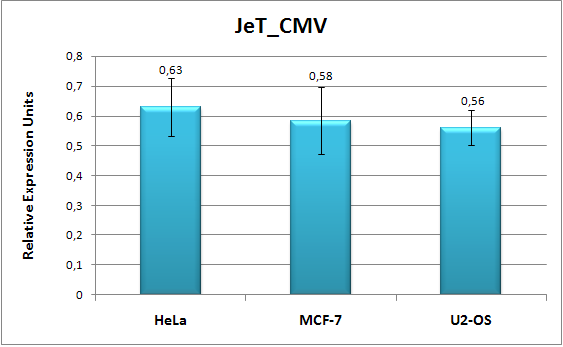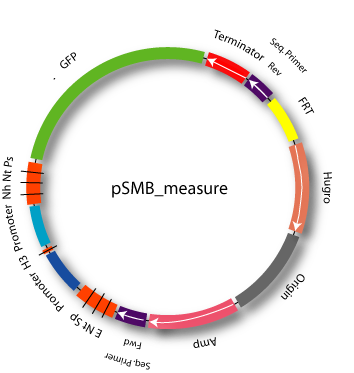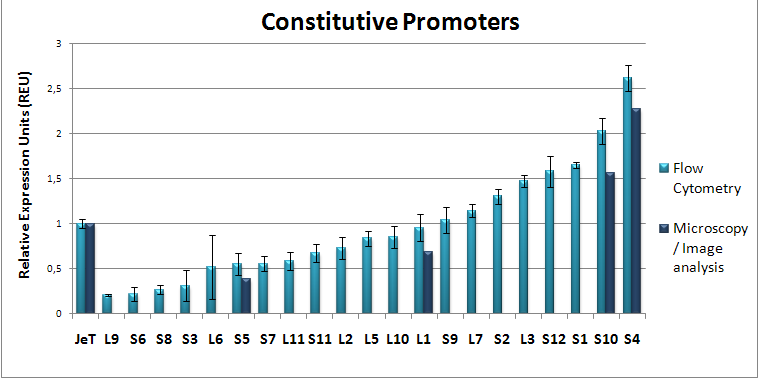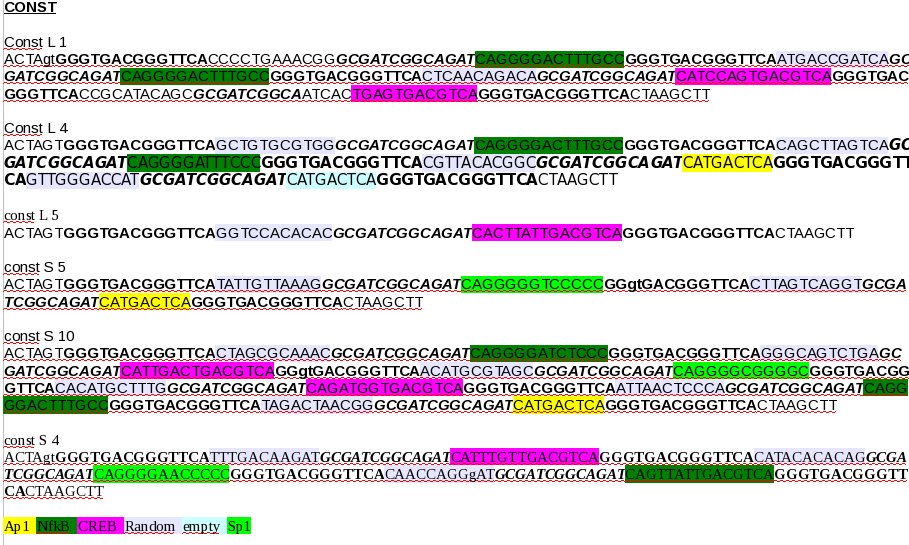Team:Heidelberg/Parts Characterization
From 2009.igem.org
(New page: __NOTOC__ {{Template_HD_3}} <html> <style = "text/css"> #body {margin: 0} </style> <body id="project"></body></html> {| valign="top" border="0" |width="900px" style="padding: 0 15px 15px ...) |
|||
| Line 11: | Line 11: | ||
__NOTOC__ | __NOTOC__ | ||
| + | = Charcterized parts = | ||
| + | |||
| + | == Measurement Kit == | ||
| + | |||
| + | [[Team:Heidelberg/Project_Measurement|''Main Article: Measurement'']] | ||
| + | |||
| + | ===[http://partsregistry.org/wiki/index.php?title=Part:BBa_K203100 Part:BBa_K203100]=== | ||
| + | |||
| + | [[Image:HD09_p31.png|thumb|left|385px|'''Fig. 3: Plasmid map of pSMB_MEASURE.''' BBB sites are shown in red, core promoter in light blue and proximal promoter in dark blue.]]We created a plasmid , pSMB_MEASURE (SMB is for Synthetic Mammalian Biology; [http://partsregistry.org/wiki/index.php?title=Part:BBa_K203100 Part:BBa_K203100]), which should be used for promoter characterization in mammalian cells. pSMB_MEASURE (see Fig. 3) contains a reference promoter, JeT[[Team:Heidelberg/Project_Measurement#References|[9]]] ([http://partsregistry.org/wiki/index.php?title=Part:BBa_K203112 Part:BBa_K203112]), which is flanked by BBb_2 (Tom Knight) sites and can therefore be replaced by the promoter to be measured. JeT is ideal as a reference promoter for a variety of reasons. First, it has an intermediate expression strength; second, it is regulated by a wide variety of transcription factors and low levels of change in fluorescence among different conditions (compare [[Team:Heidelberg/Project_Measurement#There_are_no_truly_constitutive_promoters_in_mammalian_cells|discussion]])[[Team:Heidelberg/Project_Measurement#References|[9]]]. Third, we want to pay tribute to its creators as pioneers in synthetic promoter research. <br> | ||
| + | We separated JeT's core promoter from its proximal promoter by a HindIII site; it can therefore be used for [[Team:Heidelberg/Project_Synthetic_promoters#Method_detail_–_random_synthesis_(RA-PCR)|screening of synthetic proximal promoters]] or for modifying the strength of a promoter by [[Team:Heidelberg/Project_Measurement#Different_core_promoters_result_in_different_expression_strength|core promoter swapping]]. In addition, it contains a FRT site which will allow for stable integration into mammalian cells also containing a FRT site. Thus, it provides the possibility to characterize the promoter in a defined genome and in this way helps to avoid some of the [[Team:Heidelberg/Project_Measurement#Identification_of_challenges_unique_to_higher_eukaryotes|challenges outlined above]]. For the same reason, it also contains a mammalian selection marker (hygromycine). For the generation of the plasmid, please see [http://partsregistry.org/Part:BBa_K203100:Design part design]. As a reporter gene, it contains GFP, which is followed by a SV40 mammalian terminator. We generated another plasmid pSMB_REFERENCE, which contains mcherry instead of GFP. It can be used for normalizations to transfection efficiency in Flow cytometry and image analysis. | ||
| + | |||
| + | == Core promoters == | ||
| + | |||
| + | [[Team:Heidelberg/Project_Measurement#Different_core_promoters_result_in_different_expression_strength|''Main Article: Core promoters'']] | ||
| + | |||
| + | === [http://partsregistry.org/wiki/index.php?title=Part:BBa_K203113 Part:BBa_K203113] === | ||
| + | |||
| + | We cloned the CMV core promoter from [http://partsregistry.org/Part:BBa_I712004 Part:BBa_I712004] in front of the JeT proximal promoter from part [http://partsregistry.org/wiki/index.php?title=Part:BBa_K203112 Part:BBa_K203112] to obtain JeT_CMV. We characterized this construct in three different cell lines, HeLa, MCF-7, and U2-OS and found it to have 50%-60% percent of JeT's activtiy depending on the cell line (Fig. 6). Thereby, the HeLa cell line was measured five times and the MCF-7 and U2-OS cell line measurements were performed four times. The fact that variations in the core promoter can be used to vary expression strength of a certain promoter of interest comes in useful if the transfer function of an existing promoter is to be altered, and it can be used to further diversify the synthetic promoters we created. We characterized these promoters by the same methods and accuracy as CMV and JeT/CMV (see [[Team:Heidelberg/Project_Synthetic_promoters|Synthetic Promoter project]]) | ||
| + | |||
| + | [[Image:JeT_CMV_standard2.png|thumb|left|300px|'''Figure 6: Flow cytometry measurement data of JeT_CMV (REU) in different cell lines.''' The three cell lines MCF-7, U2-OS, and HeLa were cotransfected with the JeT_CMV promoter coupled to GFP and a reference plasmid including the promoter JeT coupled to mCherry. The relative fluorescence (REU) of GFP was measured 20 hours after transfection. The MCF-7 and the U2-OS cell line were measured four times and the HeLa cell line five times. The standard error of the mean (SEM) is indicated by the error bars. ]] | ||
| + | |||
| + | |||
| + | |||
| + | |||
| + | == Promoters created by RA-PCR == | ||
| + | |||
| + | [[Team:Heidelberg/Project_Synthetic_promoters|''Main article: Synthetic promoters'']] | ||
| + | |||
| + | All contain the core promoter of [http://partsregistry.org/wiki/index.php?title=Part:BBa_K203112 Part:BBa_K203112] and were screened / measured in [http://partsregistry.org/wiki/index.php?title=Part:BBa_K203100 Part:BBa_K203100]. | ||
| + | |||
| + | === [http://partsregistry.org/wiki/index.php?title=Part:BBa_K203110 Part:BBa_K203110], [http://partsregistry.org/wiki/index.php?title=Part:BBa_K203118 Part:BBa_K203118],[http://partsregistry.org/wiki/index.php?title=Part:BBa_K203111 Part:BBa_K203111],[http://partsregistry.org/wiki/index.php?title=Part:BBa_K203109 Part:BBa_K203109] and others === | ||
| + | |||
| + | As a first application of RA-PCR, we have created a library of constitutive promoters. We performed RA-PCR on oligos containing binding sites for some well known generally activating transcription factors ([[Team:Heidelberg/Eucaryopedia#Sp1|Sp1]], [[Team:Heidelberg/Eucaryopedia#Ap1|Ap1]],[[Team:Heidelberg/Eucaryopedia#CREB|CREB]], [[Team:Heidelberg/Eucaryopedia#NF-Y|NF-Y]]) which we identified from literature search [[Team:Heidelberg/Project_Synthetic_promoters#References|[8]]],[[Team:Heidelberg/Project_Synthetic_promoters#References|[7]]],[[Team:Heidelberg/Project_Synthetic_promoters#References|[10]]]. We also added [[Team:Heidelberg/Eucaryopedia#Transcription_factors|NF-κB]] responsive oligos as NF-κB has non-specific activity and is therefore used by a variety of viral constitutive promoters, e.g. the HIV promoter [[Team:Heidelberg/Project_Synthetic_promoters#References|[13]]]. We picked 24 colonies, two of which we dismissed after a test digest (not shown). Figure 3 shows the sequence analysis of some randomly selected clones and demonstrates that RA-PCR is able to generate randomized repeats of oligos. We then measured the activity of the clones we picked by applying the [[Team:Heidelberg/Project_Measurement|Concept of Relative Expression Units (REU)]] we developed. Figure 2 shows that we have been able to create a library of promoters of varying strength, some of which have an expression strength higher than JeT (which was not accomplished by JeT's developers, although attempted [[Team:Heidelberg/Project_Synthetic_promoters#References|[10]]]). Such a library is of great value for fine-tuning gene expression levels. Selected clones were characterized by an independent method (image analysis) and submitted to the registry. | ||
| + | {| class="wikitable centered" border="0" rules="rows"" | ||
| + | |- | ||
| + | |[[Image:HD09_constitutive.png|left|thumb|350px|'''Figure 2: A library of constitutive promoters created by RA-PCR''' Promoters were analyzed by the standards developed in the [[Team:Heidelberg/Project_Measurement#Measuring REU_by_flow_cytometry_and_image_analysis|Measurement]] part of our project in [[Team:Heidelberg/Eucaryopedia#HeLa|HeLa cells.]] ]] | ||
| + | |||
| + | |[[Image:HD09_0109_const.jpg|left|thumb|350px|'''Figure 3: RA-PCR generates randomized repeats of transcription factor binding sites.''' Sequence analysis of clones of constitutive promoters generated by RA-PCR. Transcription factor binding sites are marked in color, random sequences in light grey. Annealing sequences are shown in bold and bold italic.]] | ||
| + | |- | ||
| + | |} | ||
| + | |||
| + | |||
| + | |||
| + | == HEARTBEAT Predicted promoters == | ||
| + | |||
| + | '''coming soon...''' | ||
| + | |||
| + | == Natural promoters == | ||
| + | |||
| + | [[Team:Heidelberg/Project_Natural_promoters|''Main article: Natural promoters'']] | ||
| + | |||
| + | {| class="wikitable centered" style="margin: 1em auto 1em auto" | ||
| + | |- style="background-color:#99cccc;" | ||
| + | ! height=20px, width=250px | Name || width=150px | Part type || width=150 | Registry link | ||
| + | |- style="background-color:#9BDDFF;" | ||
| + | | style="font-weight:bold;" | LDL receptor promoter (sterol regulated) || Regulatory || [http://partsregistry.org/wiki/index.php?title=Part:BBa_K203105 Part:BBa_K203105] | ||
| + | |- style="background-color:#9BDDFF;" | ||
| + | | style="font-weight:bold;" | HMG-CoA synthase promoter (sterol regulated) || Regulatory || [http://partsregistry.org/Part:BBa_K203106 Part:BBa_K203106] | ||
| + | |- style="background-color:#9BDDFF;" | ||
| + | | style="font-weight:bold;" | c-Jun promoter (growth factor regulated) || Regulatory || [http://partsregistry.org/Part:BBa_K203107 Part:BBa_K203107] | ||
| + | |- | ||
| + | |} | ||
| + | |||
| + | == Targeting Signals == | ||
| + | |||
| + | [[Team:Heidelberg/Project_SaO|''Main article: Outlook and Summary'']] | ||
| + | |||
| + | Protein domains for targeting to sub-cellular compartments. | ||
| + | |||
| + | {| class="wikitable centered" style="margin: 1em auto 1em auto" | ||
| + | |- style="background-color:#99cccc;" | ||
| + | ! height=20px, width=250px | Name || width=150px | Part type || width=150 | Registry link | ||
| + | |- style="background-color:#9BDDFF;" | ||
| + | | style="font-weight:bold;" | Plasma membrane targeting (GPI anchor) || Protein domain || [http://partsregistry.org/wiki/index.php?title=Part:BBa_K203000 Part:BBa_K203000] | ||
| + | |- style="background-color:#9BDDFF;" | ||
| + | | style="font-weight:bold;" | Plasma membrane targeting (myrpalm) || Protein domain || [http://partsregistry.org/Part:BBa_K203108 Part:BBa_K203108] | ||
| + | |- style="background-color:#9BDDFF;" | ||
| + | | style="font-weight:bold;" | ER membrane targeting (C-terminal) || Protein domain || [http://partsregistry.org/Part:BBa_K203101 Part:BBa_K203101] | ||
| + | |- style="background-color:#9BDDFF;" | ||
| + | | style="font-weight:bold;" | ER membrane targeting (N-terminal) || Protein domain || [http://partsregistry.org/Part:BBa_K203124 Part:BBa_K203124] | ||
| + | |- style="background-color:#9BDDFF;" | ||
| + | | style="font-weight:bold;" | mCherry-myrpalm-polyA || Composite || [http://partsregistry.org/Part:BBa_K203116 Part:BBa_K203116] | ||
| + | |- | ||
| + | |- style="background-color:#9BDDFF;" | ||
| + | | style="font-weight:bold;" | GFP-polyA || Composite || [http://partsregistry.org/Part:BBa_K203117 Part:BBa_K203117] | ||
| + | |- | ||
| + | |} | ||
| + | |||
| + | |width="250px" style="background-color:#d8d5d0"| | ||
| + | |||
| + | |} | ||
|width="250px" style="padding: 0 20px 15px 15px; background-color:#d8d5d0"| | |width="250px" style="padding: 0 20px 15px 15px; background-color:#d8d5d0"| | ||
Revision as of 14:29, 20 October 2009
|
Charcterized partsMeasurement Kit[http://partsregistry.org/wiki/index.php?title=Part:BBa_K203100 Part:BBa_K203100]We created a plasmid , pSMB_MEASURE (SMB is for Synthetic Mammalian Biology; [http://partsregistry.org/wiki/index.php?title=Part:BBa_K203100 Part:BBa_K203100]), which should be used for promoter characterization in mammalian cells. pSMB_MEASURE (see Fig. 3) contains a reference promoter, JeT[9] ([http://partsregistry.org/wiki/index.php?title=Part:BBa_K203112 Part:BBa_K203112]), which is flanked by BBb_2 (Tom Knight) sites and can therefore be replaced by the promoter to be measured. JeT is ideal as a reference promoter for a variety of reasons. First, it has an intermediate expression strength; second, it is regulated by a wide variety of transcription factors and low levels of change in fluorescence among different conditions (compare discussion)[9]. Third, we want to pay tribute to its creators as pioneers in synthetic promoter research. We separated JeT's core promoter from its proximal promoter by a HindIII site; it can therefore be used for screening of synthetic proximal promoters or for modifying the strength of a promoter by core promoter swapping. In addition, it contains a FRT site which will allow for stable integration into mammalian cells also containing a FRT site. Thus, it provides the possibility to characterize the promoter in a defined genome and in this way helps to avoid some of the challenges outlined above. For the same reason, it also contains a mammalian selection marker (hygromycine). For the generation of the plasmid, please see [http://partsregistry.org/Part:BBa_K203100:Design part design]. As a reporter gene, it contains GFP, which is followed by a SV40 mammalian terminator. We generated another plasmid pSMB_REFERENCE, which contains mcherry instead of GFP. It can be used for normalizations to transfection efficiency in Flow cytometry and image analysis. Core promoters[http://partsregistry.org/wiki/index.php?title=Part:BBa_K203113 Part:BBa_K203113]We cloned the CMV core promoter from [http://partsregistry.org/Part:BBa_I712004 Part:BBa_I712004] in front of the JeT proximal promoter from part [http://partsregistry.org/wiki/index.php?title=Part:BBa_K203112 Part:BBa_K203112] to obtain JeT_CMV. We characterized this construct in three different cell lines, HeLa, MCF-7, and U2-OS and found it to have 50%-60% percent of JeT's activtiy depending on the cell line (Fig. 6). Thereby, the HeLa cell line was measured five times and the MCF-7 and U2-OS cell line measurements were performed four times. The fact that variations in the core promoter can be used to vary expression strength of a certain promoter of interest comes in useful if the transfer function of an existing promoter is to be altered, and it can be used to further diversify the synthetic promoters we created. We characterized these promoters by the same methods and accuracy as CMV and JeT/CMV (see Synthetic Promoter project)  Figure 6: Flow cytometry measurement data of JeT_CMV (REU) in different cell lines. The three cell lines MCF-7, U2-OS, and HeLa were cotransfected with the JeT_CMV promoter coupled to GFP and a reference plasmid including the promoter JeT coupled to mCherry. The relative fluorescence (REU) of GFP was measured 20 hours after transfection. The MCF-7 and the U2-OS cell line were measured four times and the HeLa cell line five times. The standard error of the mean (SEM) is indicated by the error bars.
Promoters created by RA-PCRMain article: Synthetic promoters All contain the core promoter of [http://partsregistry.org/wiki/index.php?title=Part:BBa_K203112 Part:BBa_K203112] and were screened / measured in [http://partsregistry.org/wiki/index.php?title=Part:BBa_K203100 Part:BBa_K203100]. [http://partsregistry.org/wiki/index.php?title=Part:BBa_K203110 Part:BBa_K203110], [http://partsregistry.org/wiki/index.php?title=Part:BBa_K203118 Part:BBa_K203118],[http://partsregistry.org/wiki/index.php?title=Part:BBa_K203111 Part:BBa_K203111],[http://partsregistry.org/wiki/index.php?title=Part:BBa_K203109 Part:BBa_K203109] and othersAs a first application of RA-PCR, we have created a library of constitutive promoters. We performed RA-PCR on oligos containing binding sites for some well known generally activating transcription factors (Sp1, Ap1,CREB, NF-Y) which we identified from literature search [8],[7],[10]. We also added NF-κB responsive oligos as NF-κB has non-specific activity and is therefore used by a variety of viral constitutive promoters, e.g. the HIV promoter [13]. We picked 24 colonies, two of which we dismissed after a test digest (not shown). Figure 3 shows the sequence analysis of some randomly selected clones and demonstrates that RA-PCR is able to generate randomized repeats of oligos. We then measured the activity of the clones we picked by applying the Concept of Relative Expression Units (REU) we developed. Figure 2 shows that we have been able to create a library of promoters of varying strength, some of which have an expression strength higher than JeT (which was not accomplished by JeT's developers, although attempted [10]). Such a library is of great value for fine-tuning gene expression levels. Selected clones were characterized by an independent method (image analysis) and submitted to the registry.
HEARTBEAT Predicted promoterscoming soon... Natural promotersMain article: Natural promoters
Targeting SignalsMain article: Outlook and Summary Protein domains for targeting to sub-cellular compartments.
|
|width="250px" style="padding: 0 20px 15px 15px; background-color:#d8d5d0"|
|}
 "
"


